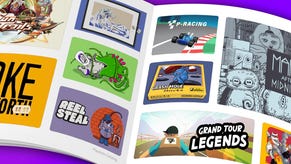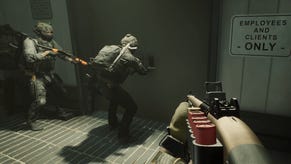"Some people want to see the slaughterhouse" - Gordon Walton
Industry veteran discusses how to successfully build and manage a crowdfunding community
Gordon Walton, President and COO at ArtCraft Entertainment, took the stage at GDC 2016 this morning to share his wisdom on crowdfunding. While Walton, a former BioWare and Sony Online exec, has been in the industry for nearly 40 years, his learnings about Kickstarter have naturally come only in the last couple. ArtCraft's campaign for Crowfall raised $1.8 million with 18,000 backers, making it the 15th largest game Kickstarter ever. The industry veteran acknowledged that he had the "unfair advantage" of being in the business a long time, but that fact alone is not enough to drive a successful crowdfunding campaign.
Walton stressed that community above all else is paramount on Kickstarter and other crowdfunding platforms. "You've got to have a community, you just can't do it without one," he said. Some developers make the mistake of thinking that they can just use the community on Kickstarter itself, but those people are not your community, he said. The idea is to build a community around an idea that's new, and then and only then can you try to use Kickstarter or indiegogo to magnify your crowd.
You have to bang the drum early and often, he said. The biggest mistake that some people have made with their campaigns is that they believed it was acceptable to launch on Kickstarter and then build the community afterwards. Walton pointed to former Sony Online president John Smedley who launched a Kickstarter campaign for his new game, Hero's Song, at Pixelmage Games. Smedley went on to cancel his Kickstarter a short time after taking it live.
"Our very first hire on our project was a community manager because we knew without building a community we had no hope no matter how cool the game was"
"John Smedley didn't do any community building before he launched the Kickstarter... I'm not picking on John, but he's just one example of people who tried to get crowdfunding without community. I heard people say 'Yeah I looked at it' but they said it didn't look like it was going to take. People want to bet on winners," Walton said.
Without a community that's passionate about your project, your campaign has no chance. "Our very first hire on our project was a community manager because we knew without building a community we had no hope no matter how cool the game was," noted Walton.
So how do you even build a community? You have to start with a highly differentiated product to begin with. "Why should I pay to support your product if I can get something very similar?" Walton said. You need to make a game not for yourself but to satisfy a certain audience. And knowing which audience to go after can make a huge difference. "You are really looking for people who have leverage with more people. You can't make a crowd from nothing unless you have a crapload of advertising dollars," Walton said.
Walton pointed out that to start it can be as easy as asking friends and family to get involved. "Who owes me? Who can I guilt sufficiently?" he asked. The idea is to get people funding your project on day one, because as you're looking to expand your crowd, they will want to see that your game is actually getting backers. Day one is crucial because the more people you can get to sign up and give a dollar initially, it increases your chances of getting Kickstarter's support. If you can get featured within the platform, that's huge because it's free advertising - a little over a quarter of Crowfall's audience was directly from Kickstarter, Walton said.
Another way to amplify your crowd is to try to get the attention of the press. And even more than the traditional press, it's a big win to get noticed by vocal members on YouTube or Twitch. "People are learning about games on YouTube or Twitch first, to the exclusion of other media," Walton pointed out.
As you begin your campaign, one of the most important details to pay attention to is your pitch video. Walton said that his was probably much too long (around seven minutes) and that the ideal length is three minutes or under. "If your video's no good you're screwed... What we think is cool about the game is not always what the audience will think is cool about the game. It may not be the selling point. You have to pick the points that will get them with you and pound those. Most people will only latch on to 3-5 things that are cool about your game but you might have 20," he said.
"If your video's no good you're screwed... What we think is cool about the game is not always what the audience will think is cool about the game"
Walton said that under 27 percent of people who started watching his pitch video actually finished it, but of those who did watch the whole thing, 36 percent went on to fund the campaign.
When communicating the crowdfunding goals and rewards, it's also critical to be completely upfront and honest about how the funds will be used, and people will want clear reasons for different reward levels. The spacing between the reward levels is important and you'll need to offer something very cool to entice people to jump up to the next level.
As the campaign continues, communication is paramount. People will want constant updates, it's a full-time job and a lot of people will want to know every intricate detail of a game's development. Many in the community will be very interested in how the sausage is made, so to speak. "Some people will want to see the slaughterhouse," Walton noted.
Having a complete communication plan is essential. How you communicate and how often are details that need to be ironed out right away, and the communication has to be done across all channels - comments, direct messages on Kickstarter, social media and more. Responsiveness is very, very important. A 24-hour window is too long to wait; 15 minutes is ideal, Walton said.
As you observe your community's dialogue, it's also important to "find and support your mavens," Walton said. You need to be watching for them, support them, and treat them a little differently. You'll know who they are because they will post a lot, and if people follow them then that's somebody you have to pay attention to, he said. Ultimately you want to give them support, materials, and tools, and you should publicly recognize their contribution to the community. "These guys are gold," Walton said because they become your best evangelists. But you don't just want cheerleaders, you also want people to hold your feet to the fire, Walton noted.
As the community builds, communication may become so overwhelming that you could need to hire people assigned to handle communication on each channel (whether it's on Kickstarter, social media or elsewhere). The key then is to make sure that your messaging stays consistent across all channels. Walton compared the community management to an MMO - it's a 24/7 job, he said.
Crowdfunding may feel like a daunting thing to undertake but you should be able to determine your likelihood of success in just the first few days. If you can't reach 25 percent of your goal in the first three days, chances are you're doomed, Walton said.









